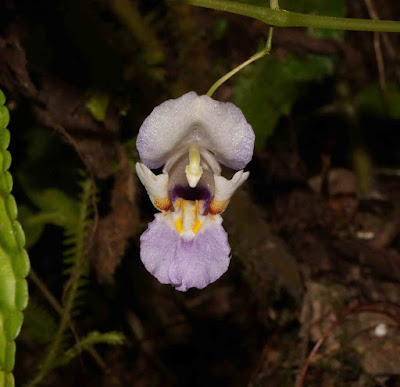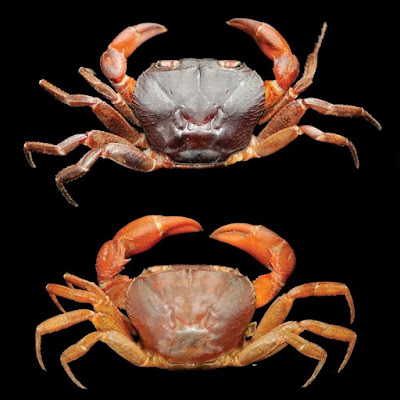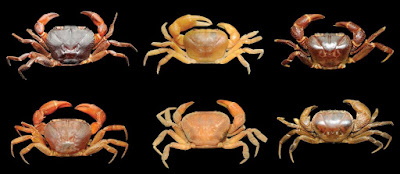[Most Recent Entries] [Calendar View]
Friday, June 16th, 2017
| Time | Event | ||
| 6:06a | [Botany • 2017] Impatiens arunachalensis • A New Species (Balsaminaceae) from northeastern India
Abstract Impatiens arunachalensis, a new species of Impatiens is described from the Upper Siang district of Arunachal Pradesh, northeast India. Detailed descriptions, distribution, and discussion of ecology along with colour photographs are provided. Keywords: Arunachal Pradesh, Balsaminaceae, Impatiens, India, new species, Siang, Eudicots Impatiens arunachalensis Hareesh, A.Joe, M.Sabu & R.Gogoi sp. nov. The new species is similar to I. arguta but differs in having prominent ovate to ovate-elliptic leaves, pedunculate flowers, broadly orbicular dorsal petals without a horn; a pouch-shaped lower sepal, suddenly constricted straight spur with coiled or annular tip and notched apex, and recurved basal lobes of lateral united petals with reddish-brown blotches. Etymology:— The specific epithet ‘arunachalensis’ references the name of the state where this species is found. Vadakkoot Sankaran Hareesh, Alfred Joe, Rajib Gogoi and Mamiyil Sabu. 2017. Impatiens arunachalensis (Balsaminaceae), A New Species from northeastern India. Phytotaxa. 305(1); 47–51. DOI: 10.11646/phytotaxa.305.1.7 | ||
| 9:25a | [Crustacea • 2017] Karkata, A New Genus of Gecarcinucid Freshwater Crab with Two New Species, and Four New Species of Pilarta and Cylindrotelphusa (Decapoda: Brachyura) from Kerala, India
ABSTRACT A new genus of freshwater crab, Karkata gen. nov., with two species, K. ghanarakta sp. nov. (type species) and K. kusumbha sp. nov., and two new species each of Pilarta Bahir and Yeo, 2007 (P. aroma sp. nov. and P. punctatissima sp. nov.) and Cylindrotelphusa Alcock, 1909 (C. breviphallus sp. nov. and C. longiphallus sp. nov.), are described from Kerala, India. Additionally, C. granulata (Pillai, 1951) comb. et stat. nov. is recognised as a distinct species. Karkata gen. nov. is distinguished from other Indian gecarcinucid genera by a suite of carapace and gonopod characters, including a moderately arched, smooth carapace, the presence of a prominent suture between male thoracic sternites 2, 3 and 3, 4, the absence of a flagellum on the third maxilliped exopod, a very short terminal segment of the male first gonopod (G1), and a short distal segment of the male second gonopod (G2). Karkata ghanarakta sp. nov. is differentiated from K. kusumbha sp. nov. by the shape of the G1 subterminal segment and its live colouration. Pilarta punctatissima sp. nov. is distinct among the congeners mainly by its densely punctate carapace, densely setose anterolateral and posterolateral margins of the carapace, stouter G1 terminal segment, and relatively long G2 distal segment whereas P. aroma sp. nov. can be separated from P. anuka Bahir and Yeo, 2007 by its relatively smooth carapace, deep H-shaped groove, relatively long G1 terminal segment, and almost straight outer margins of the G1 terminal and subterminal segments. Cylindrotelphusa breviphallus sp. nov. is differentiated from C. longiphallus sp. nov. and C. steniops (Alcock, 1909) by its stout G1, with a stout, short terminal segment. Cylindrotelphusa longiphallus sp. nov. is distinguished from the congeners by its shallow, narrow cervical grooves and relatively slender ambulatory legs. An identification key to the species of Karkata, Pilarta and Cylindrotelphusa is provided. KEYWORDS: taxonomy, Crustacea, Gecarcinucidae, Western Ghats, identification key Family GECARCINUCIDAE Rathbun, 1904 Karkata gen. nov. Type species Karkata ghanarakta sp. nov. Etymology The genus name, Karkata, means ‘crab’ in Sanskrit and Malayalam. Gender feminine. Used as a noun in apposition. Karkata gen. nov. comprises two new species: K. ghanarakta sp. nov. (type species) and K. kusumbha sp. nov. Karkata ghanarakta sp. nov. Etymology The species epithet, ghanarakta, is derived from the Sanskrit for ‘maroon’, referring to the maroon colouration of the live crabs. Used as a noun in apposition. Karkata kusumbha sp. nov. Etymology The species epithet, kusumbha (Sanskrit for ‘safflower’), alludes to the orange-red colouration of the live crabs that resemble the colour of the flowers of safflower. Used as a noun in apposition. Pilarta Bahir and Yeo, 2007 Pilarta aroma sp. nov. Etymology ‘Aroma’ means ‘hairless’ in Sanskrit. Used as a noun in apposition, alluding to the smooth or hairless carapace and chelipeds of the crab. Pilarta punctatissima sp. nov. Etymology The species epithet, punctatissima, is derived from the Latin for ‘most punctate’, referring to the densely punctate carapace of the crab. Cylindrotelphusa Alcock, 1909 Cylindrotelphusa breviphallus sp. nov. Etymology The species name is derived from the Latin ‘brevi’ for short, and the Greek ‘phallus’ for the penis, used as per the general convention in brachyuran names, referring to the short male gonopods (intromittent organs that are not analogous to a penis) of the crab. The name is used as a noun in apposition. Cylindrotelphusa longiphallus sp. nov. Etymology The species name is derived from the Latin ‘longi’ for long, and the Greek ‘phallus’ for the penis, used as per the general convention in brachyuran names, alluding to the long male gonopods (intromittent organs that are not analogous to a penis) of the crab. The name is used as a noun in apposition. S. K. Pati, L. Rajesh, Smrithy Raj, V. U. Sheeja, A. Biju Kumar & P. M. Sureshan. 2017. Karkata, A New Genus of Gecarcinucid Freshwater Crab with Two New Species, and Four New Species of Pilarta Bahir and Yeo, 2007 and Cylindrotelphusa Alcock, 1909 (Decapoda: Brachyura) from Kerala, India. Journal of Natural History. DOI: 10.1080/00222933.2017.1324054 | ||
| 2:32p | [Botany • 2017] Strobilanthes namkadingensis • A New Species of Yellow-flowered Strobilanthes (Acanthaceae) from central Laos [Flora of Nam Kading National Protected Area I]
Abstract A new species of Acanthaceae, Strobilanthes namkadingensis Soulad. & Tagane from Nam Kading National Protected Area, Bolikhamxay Province, central Laos, is described and illustrated. It is characterized by long spicate inflorescences consisting of 6-32 flowers, yellow corolla, the absence of long white hairs on the bracts and 4–6 seeds per capsule. Three DNA barcode regions of the partial genes for the large sub-unit ribulose-1,5-bisphosphate carboxylase oxygenase (rbcL) and maturase K (matK) and internal transcribed spacers (ITS) are also provided. Keywords: DNA barcoding, Indochina, Laos, Sericocalyx, taxonomy Strobilanthes namkadingensis Soulad. & Tagane, sp. nov. Diagnosis: Strobilanthes namkadingensis is distinguished from all the previously known species of Laos and its surrounding countries including China, Cambodia, Thailand and Vietnam clearly by a combination of 6–32 flowered spikes up to 10.5 cm long, yellow corolla, the absence of long white hairs on the bracts and 4–6-seeded capsule. In the region, S. namkadingensis is similar to Strobilanthes squalens S.Moore of Vietnam and Sericocalyx thailandicus Bremek. of Thailand in having yellow corolla and long-beaked floral bracts, but distinguished by its long spikes (vs. less than 3 cm long), broader floral bracts (obovate-elliptic to broadly elliptic vs. lanceolate to ovate-lanceolate), smaller corolla (1.9–2.1 cm long vs. less than 1.7 cm long), and the absence of long white hairs on the bracts. Distribution: Laos, Bolikhamxay Province (so far known only from Nam Kading National Protected Area). Habitat and ecology: Strobilanthes namkadingensis is found in semi-shaded understory of semi-evergreen forest beside a dried stream; at alt. 146 m. The flowering and fruiting specimen was collected in December. Etymology: This specific epithet namkadingensis refers to the type locality. Phetlasy Souladeth, Shuichiro Tagane, Meng Zhang, Norikazu Okabe and Tetsukazu Yahara. 2017. Flora of Nam Kading National Protected Area I: A New Species of Yellow-flowered Strobilanthes (Acanthaceae), S. namkadingensis. PhytoKeys. 81; 11-17. DOI: 10.3897/phytokeys.81.13203 |
| << Previous Day |
2017/06/16 [Calendar] |
Next Day >> |








